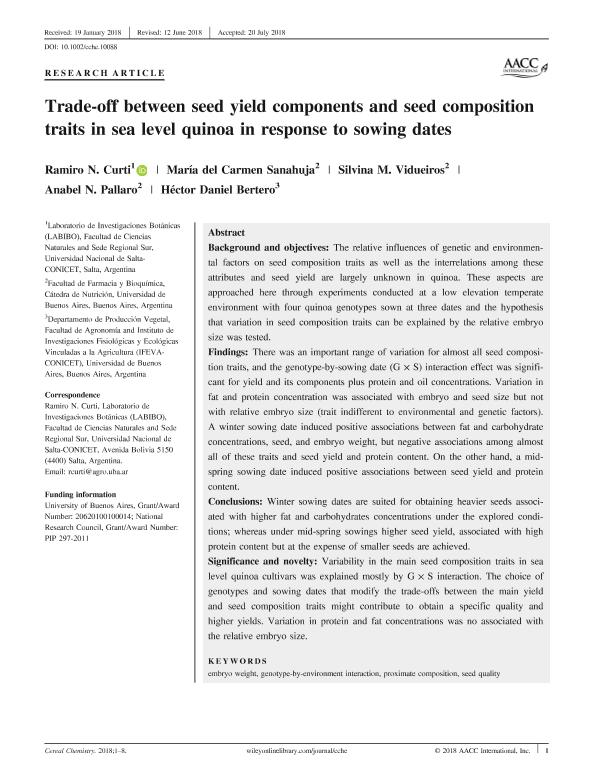Artículo
Trade-off between seed yield components and seed composition traits in sea level quinoa in response to sowing dates
Curti, Ramiro Nestor ; Sanahuja, María del Carmen; Vidueiros, Silvina M.; Pallaro, Anabel Nora; Bertero, Hector Daniel
; Sanahuja, María del Carmen; Vidueiros, Silvina M.; Pallaro, Anabel Nora; Bertero, Hector Daniel
 ; Sanahuja, María del Carmen; Vidueiros, Silvina M.; Pallaro, Anabel Nora; Bertero, Hector Daniel
; Sanahuja, María del Carmen; Vidueiros, Silvina M.; Pallaro, Anabel Nora; Bertero, Hector Daniel
Fecha de publicación:
09/2018
Editorial:
Amer Assoc Cereal Chemists
Revista:
Cereal Chemistry
ISSN:
0009-0352
Idioma:
Inglés
Tipo de recurso:
Artículo publicado
Clasificación temática:
Resumen
Background and objectives: The relative influences of genetic and environmental factors on seed composition traits as well as the interrelations among these attributes and seed yield are largely unknown in quinoa. These aspects are approached here through experiments conducted at a low elevation temperate environment with four quinoa genotypes sown at three dates and the hypothesis that variation in seed composition traits can be explained by the relative embryo size was tested. Findings: There was an important range of variation for almost all seed composition traits, and the genotype-by-sowing date (G × S) interaction effect was significant for yield and its components plus protein and oil concentrations. Variation in fat and protein concentration was associated with embryo and seed size but not with relative embryo size (trait indifferent to environmental and genetic factors). A winter sowing date induced positive associations between fat and carbohydrate concentrations, seed, and embryo weight, but negative associations among almost all of these traits and seed yield and protein content. On the other hand, a mid-spring sowing date induced positive associations between seed yield and protein content. Conclusions: Winter sowing dates are suited for obtaining heavier seeds associated with higher fat and carbohydrates concentrations under the explored conditions; whereas under mid-spring sowings higher seed yield, associated with high protein content but at the expense of smaller seeds are achieved. Significance and novelty: Variability in the main seed composition traits in sea level quinoa cultivars was explained mostly by G × S interaction. The choice of genotypes and sowing dates that modify the trade-offs between the main yield and seed composition traits might contribute to obtain a specific quality and higher yields. Variation in protein and fat concentrations was no associated with the relative embryo size.
Archivos asociados
Licencia
Identificadores
Colecciones
Articulos(CCT - SALTA-JUJUY)
Articulos de CTRO.CIENTIFICO TECNOL.CONICET - SALTA-JUJUY
Articulos de CTRO.CIENTIFICO TECNOL.CONICET - SALTA-JUJUY
Articulos(IFEVA)
Articulos de INST.D/INV.FISIOLOGICAS Y ECO.VINCULADAS A L/AGRIC
Articulos de INST.D/INV.FISIOLOGICAS Y ECO.VINCULADAS A L/AGRIC
Citación
Curti, Ramiro Nestor; Sanahuja, María del Carmen; Vidueiros, Silvina M.; Pallaro, Anabel Nora; Bertero, Hector Daniel; Trade-off between seed yield components and seed composition traits in sea level quinoa in response to sowing dates; Amer Assoc Cereal Chemists; Cereal Chemistry; 95; 5; 9-2018; 734-741
Compartir
Altmétricas



